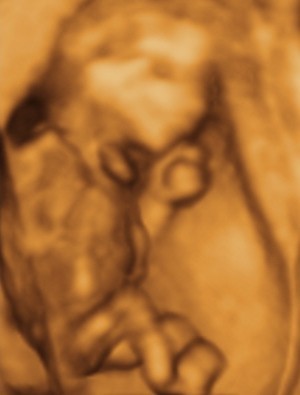The birth of a child is always amazing, and each baby is awesome. But as a parent, when you find yourself with the little one in your arms, you look at him like an alien. Not that you wouldn’t love him, but as The Kelly Family’s song says – “I’m in love with an alien“. He doesn’t look like you’ve imagined. He merely looks like a human being.
And he truly isn’t a man like all the others. Yet.
You can understand how great the miracle through which a being came to life, just by looking closely – at least in some details, if not the whole process. And if you stop for a moment to think at the amazing complexity and harmony which appears almost out of nothing, it gives you shivers.
On this page:
- 1 The being from mother’s womb
- 2 Summer is not like winter, girls are not like boys
- 3 How do the little ones face life
- 4 Transforming into a new being isn’t easy
- 5 Everyone has nipples, but not milk?!
- 6 Why are babies cute?!
- 7 Babies can’t speak, but they can tell you what they want
- 8 What’s going on in the head of the little ones?!
The being from mother’s womb

From conception until the moment of birth, a fetus grows in weight 3 billion times. That means gaining weight! Well, where’s better than at mom’s “home“?!
In the uterus, after 5 months, the fetus is covered with a fine and soft “wool”, called lanugo (from the Latin “lana”). Usually it disappears shortly before birth, so most people aren’t aware of its existence. But there are cases (especially to those born prematurely) when the baby presents himself to the world with fur on him (sometimes only on small areas of the skin). Lanugo disappears in a few days, but it is enough for the family to raise a brow 1)”Amazing Baby” by Desmond Morris, book published by Firefly Books in 2008.
At birth, babies have about 270-350 bones, the number varying from case to case. That makes them perfect contortionists. Can you imagine what it is like to be cramped day by day?! But once the space constraint is gone, some bones merge with one another, leaving only 206. Kneecaps don’t exist yet; these develop until the age of 6 months and even after, until they completely ossify.
Summer is not like winter, girls are not like boys

The differences between the sexes can easily be seen from the outside. But going beyond this, they are in fact profound and influence both anatomy and psychology of the new being.
The boys have more muscle fibers than girls at birth. On average, muscles grow about 40 times until maturity 2)”Amazing Baby” by Desmond Morris, book published by Firefly Books in 2008. So, an adult can face an army of 40 babies. But how to resist them?!
Even boys’ brains are surprisingly different from girls’ brains. The male brain gets another structure and functions differently because it is influenced by testosterone, which is produced by the testicles (in case you were wondering where all the trouble comes from). Differences are so big, even from week 26 of gestation an expert can determine the sex of the child by watching his brain 3)”Amazing Baby” by Desmond Morris, book published by Firefly Books in 2008. For example, boys have more asymmetric hemispheres than girls and more white matter than gray matter. But differences are much more complex at a structural level. And they leave an imprint/mark on the entire further evolution.
How do the little ones face life
Even though a fetus has lungs, he can’t breathe in his mother’s womb, that’s why the lungs are inactive. The fetus gets his oxygen from his mother, through the cord and gets rid of the carbon dioxide in the same way. For his special circulation to take place, his heart has an opening between the left and the right atrium 4)”Amazing Baby” by Desmond Morris, book published by Firefly Books in 2008.
At the moment of birth, guess what happens when the umbilical cord is cut? The newborn simply suffocates. The shock produced in the little one’s body makes the extra hole in the heart close, makes the blood flow adapt to the new situation and the lungs to activate themselves. In just a few moments, he virtually becomes a being with a whole new type of functioning. And he shouts out loud the “declaration of independence”!
And he breathes, no joke! About 40 breaths per minute, well above that of an adult (10-20).
Similarly, the heart of a newborn beats very fast – 180 pulsations/minute, more than double that of an adult’s, who usually has a pulse of 70-80 (something more when you see your child for the first time). As a comparison, the newborn has the pulse of a jogger. No wonder that the little one is tired all the time, sleeping more than 16 hours a day!
Transforming into a new being isn’t easy
Newborns have 10,000 taste buds in their mouth. There are so many, that not all of them find their place on the tongue, they are spread throughout the mouth. All that matters for the little one is to be fed – when the milk comes, he will completely feel it. Then, step-by-step, the number of taste buds will decrease. Interesting is the fact that despite the highly developed taste ability, babies cannot taste salty until 4 months.
When the fetus is born, he has meconium in his intestines 5)”Meconium” in Wikipedia, a pasty, soft substance. This keeps the intestine ready for the first meal, which will produce feces.
Shortly after birth, some babies take on a bizarre look, called “the harlequin effect”: half of the body is an intense red color, while the other half is pale 6)”Amazing Baby” by Desmond Morris, book published by Firefly Books in 2008. Fortunately it is something harmless, a temporary dilatation of some blood vessels, but I’d be curious what kind of colors parents faces change when they see such a horror.
Everyone has nipples, but not milk?!
About 4-5% of newborn babies milk leaks through their nipples 7)”Amazing Baby” by Desmond Morris, book published by Firefly Books in 2008. Baby wants to breastfeed, pure and simple. As his/her mom. That occurs due to the hormonal transfer that takes place in the uterus of the mother to the fetus, but also due to own hormonal processes of the fetus. In many European cultures, this phenomenon, which can take place for two months, is popularly called “the witch’s milk”, the belief being that, that a witch is stealing the children’s milk to feed their animal spirit.8)”Witch’s milk” in Wikipedia.
As the baby cannot yet chew, his first food is milk, usually from his mother’s breast. But guess what: the suckling doesn’t suck! There is no suction from the baby’s mouth, but a tightening of the area around the nipple. Practically, the little one squeezes the milk. He shouldn’t be called “suckling”, but “squeezer” (mothers know why).
Speaking about breastfeeding, did you know that men can do it, too? Functionally, everything is available for lactation to take place, but it also requires a hormonal stimulation, which can be done through medication (intentionally or as a side effect), very rare, even spontaneously 9)”Strange but True: Males Can Lactate” by Nikhil Swaminathan, article published in Scientific American on 6th of September 2007. In some regions of Africa, it is even a tradition that fathers play the role of mothers 10)”Are the men of the African Aka tribe the best fathers in the world?” – Joanna Moorhead in dialogue with anthropologist Barry Hewlett, article published in The Guardian on 15th of June 2005. Newborns don’t have any restraint – besides bottle, any nipple is a pleasure.
Why are babies cute?!
When you watch a baby, you get a special feeling. They seem nice, even if you don’t know them too well, but you know them very well (they just don’t let you sleep all night long).
And it isn’t only true for human offspring, but even for the cubs of many animals. Puppies tend to make everyone get a special feeling. (Unless you’re a man and somebody is looking at you.)

But what makes us have this reaction? It is a complex of factors, but some studies show that some of those are linked to the anatomical features 11)”Baby Schema in Infant Faces Induces Cuteness Perception and Motivation for Caretaking in Adults” – study carried out by Melanie L. Glocker, Daniel D. Langleben, Kosha Ruparel, James W. Loughead, Ruben C. Gur and Norbert Sachser, published in Ethology from March 2009.
Especially the eyes. Babies have much larger eyes in reference to the entire body. (“Baby, how big your eyes are!” “So that I can soften you better!“) It seems like we are genetically conditioned to react positively at seeing big eyes. And as eyes reach the maximum size during the age of 3 months, while the rest of the body has to grow a lot more, the impact is maximum.
The same goes for the head. It is bigger than the rest of the body (a quarter), with an obvious symmetry. And for the “softening” to be complete the nose and the mouth are very little. (Just good to be “eaten” if we take a survey among the family members.)
Babies can’t speak, but they can tell you what they want
Did I say “little mouth”?! It looks like that until they begin to scream. I said scream not cry – because the newborns don’t have tears until the age of 3 weeks and some of them need 4-5 months to discover tearful crying.
When they scream, everyone knows (parents, grandparents, neighbors). But this little thing hides something very interesting: until they are 3-6 months old, babies don’t do it emotionally. It is only an instinctive way of communication, which can be found in all mammals, through which the little creatures express the discomfort state and through which they ask for help.
Emotional crying appears only when babies can distinguish the others around. Sometimes even with manipulative tendencies. If it works, why not apply the method to get what they want?! (We accept answers to the question only if they can be understood by a baby.)
Luckily babies discover also other modalities of communication. At the age of 2-3 months, the first smiles appear. Although at the beginning are mere random or genetically inherited gestures (here are different opinions), babies come quickly to the knowledge that so can be obtained the attention of those around him. And when you are a conqueror it’s hard to stop conquering everyone – so I smile with joy to all of them! (A very good habit, which shouldn’t be lost – but, unfortunately, it lasts only for a few months.)
What’s going on in the head of the little ones?!
The newborn’s brain is small, but in the first few days after birth it grows extremely fast, up to 1% per day, reaching a growth of 60% in the first 90 days of his existence outside the mother’s womb 12)”Structural Growth Trajectories and Rates of Change in the First 3 Months of Infant Brain Development” – study conducted by Dominic Holland, Ph.D., Linda Chang, M.D., Thomas M. Ernst, Ph.D., Megan Curran, Steven D. Buchthal, Ph.D., Daniel Alicata, M.D., Jon Skranes, M.D., Heather Johansen, Antonette Hernandez, Robyn Yamakawa, Joshua M. Kuperman, Ph.D., Anders M. Dale, Ph.D., published in JAMA Neurology on 11th of August 2014. In a way, it is an opening bud. It’s just that this blossom continues, even if it takes place in a slower and slower rhythm: at the age of one the brain is double relative to the moment of birth, but only 60% from maximum, which is reached only at the age of 20 (although by the age of kindergarten the brain is almost fully developed).

The brain of a premature newborn is smaller, but that doesn’t mean that they will be less smart/intelligent. There are many examples of geniuses which rushed to appear: Albert Einstein, Isaac Newton, Johannes Kepler, Charles Darwin, Jean-Jacques Rousseau, Johann Wolfgang von Goethe, Mark Twain, Victor Hugo, Pablo Picasso, Auguste Renoir, Winston Churchill, etc.
If we look at weight, the newborn’s brain represents 10% of the entire body 14)”Amazing Baby” by Desmond Morris, book published by Firefly Books in 2008. To an adult that proportion drops to 2%. It seems like at birth, babies needs a lot more brain than muscles. If human species evolution continues, they will stick their head out and will ask for a chocolate milk.
Some scientists speculate that this brain development of the child is a replay on fast forward of the entire evolutionary process of Homo Sapiens. The brain of the monkey’s offspring resembles, more at the moment of birth, that of the human’s baby than it does at maturity. (So, it looks like the endearment “little monkey” is not really used by chance.)
Little children don’t have long term memories until the age of 3 (more or less, from case to case), that which scientifically is called “infantile amnesia” 15)”Childhood amnesia” in Wikipedia. As a parent, you find that out on your own walls – in which children don’t seem to remember it is not allowed to write, nor to give food to, etc. Well, the little ones have the perfect excuse: they really don’t remember!
(Psss! I’ll tell you something, but you keep it between us, because I don’t want to set myself against the little ones. At my second birthday, my parents did a birthday party at home, with my godfathers and a few other guests. I vividly remember how they lifted me up in their arms from the bedroom and took me through that guests’ agitation, in the dinning room, where I was put on the table, in front of the cake. I put my finger in the frosting, to the delight of all – and especially mine, when I licked it. So, it isn’t impossible for a child to have long-term memories. But I think that frosting or something is needed.)
Babies have difficulty when it comes to memorizing long term simply due to accelerated development of nerve cells in hippocampus (the part of the brain that holds memories) 16)”Infantile amnesia: A neurogenic hypothesis” – study conducted by Sheena A. Josselyn and Paul W. Frankland in 2012. It’s just a construction site, fast rhythm, a flow/avalanche of information, which has to find their place. As the transformations are major, some memories become inaccessible at some development thresholds.
These are babies. Some strange beings. Like I was, like you were…
All about the development of vision in children, with fascinating facts about eyes.
References
| ↑1, ↑2, ↑3, ↑4, ↑6, ↑7, ↑14 | ”Amazing Baby” by Desmond Morris, book published by Firefly Books in 2008 |
|---|---|
| ↑5 | ”Meconium” in Wikipedia |
| ↑8 | ”Witch’s milk” in Wikipedia |
| ↑9 | ”Strange but True: Males Can Lactate” by Nikhil Swaminathan, article published in Scientific American on 6th of September 2007 |
| ↑10 | ”Are the men of the African Aka tribe the best fathers in the world?” – Joanna Moorhead in dialogue with anthropologist Barry Hewlett, article published in The Guardian on 15th of June 2005 |
| ↑11 | ”Baby Schema in Infant Faces Induces Cuteness Perception and Motivation for Caretaking in Adults” – study carried out by Melanie L. Glocker, Daniel D. Langleben, Kosha Ruparel, James W. Loughead, Ruben C. Gur and Norbert Sachser, published in Ethology from March 2009 |
| ↑12 | ”Structural Growth Trajectories and Rates of Change in the First 3 Months of Infant Brain Development” – study conducted by Dominic Holland, Ph.D., Linda Chang, M.D., Thomas M. Ernst, Ph.D., Megan Curran, Steven D. Buchthal, Ph.D., Daniel Alicata, M.D., Jon Skranes, M.D., Heather Johansen, Antonette Hernandez, Robyn Yamakawa, Joshua M. Kuperman, Ph.D., Anders M. Dale, Ph.D., published in JAMA Neurology on 11th of August 2014 |
| ↑13 | ”Essence of Pediatrics” by Prof. MR Khan and Prof. M Ekhlasur Rahman, book published by Elsevier India in 2011 |
| ↑15 | ”Childhood amnesia” in Wikipedia |
| ↑16 | ”Infantile amnesia: A neurogenic hypothesis” – study conducted by Sheena A. Josselyn and Paul W. Frankland in 2012 |
Did you like it? Now it’s your turn. You’ll make us very happy if you share this article with your friends:
And don’t forget to let us know what you think – we are really interested in your thoughts on this!




No longer very fond of humans overall in general and their endless ongoing babies productions nevertheless found your Miratico Superbaby article analyses revelations insights overall very engaging informative fascinating – thanks alot!!!!